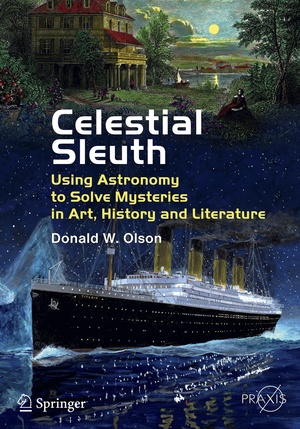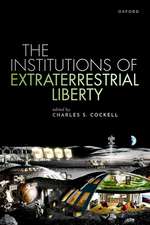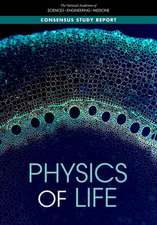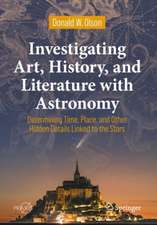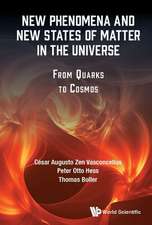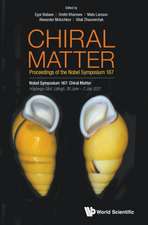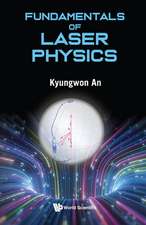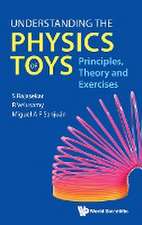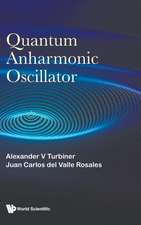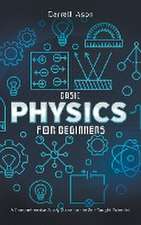Celestial Sleuth: Using Astronomy to Solve Mysteries in Art, History and Literature: Springer Praxis Books
Autor Donald W. Olsonen Limba Engleză Paperback – 3 oct 2013
Weather facts, volcano studies, topography, tides, historical letters and diaries, famous paintings, military records, and the friendly assistance of experts in related fields add variety, depth, and interest to the work. The chosen topics are selected for their wide public recognition and intrigue, involving artists such as Vincent van Gogh, Claude Monet, Edvard Munch, and Ansel Adams; historical events such as the Battle of Marathon, the death of Julius Caesar, the American Revolution, and World War II; and literary authors such as Chaucer, Shakespeare, Joyce, and Mary Shelley. This book sets out to answer these mysteries indicated with the means and expertise of astronomy, opening the door to a richer experience of human culture and its relationship with nature.
Each subject is carefully analyzed. As an example using the study of sky paintings by Vincent van Gogh, the analytical method would include:
- computer calculations of historical skies above France in the 19th century
- finding and quoting the clues found in translations of original letters by Van Gogh
- making site visits to France to determine the precise locations when Van Gogh set up his easel and what celestial objects are depicted.
For each historical event influenced by astronomy, there would be a different kind of mystery to be solved. As an example:
- How can the phase of the Moon and time of moonrise help to explain a turning point of the American Civil War - the fatal wounding of Stonewall Jackson at Chancellorsville in 1863?
For each literary reference to astronomy, itwas determined which celestial objects were being described and making an argument that the author is describing an actual event. For example, what was the date of the moonlit scene when Mary Shelley first had the idea for her novel “Frankenstein?”
These and more fun riddles will enchant and delight the fan of art and astronomy.
Din seria Springer Praxis Books
-
 Preț: 294.46 lei
Preț: 294.46 lei -
 Preț: 223.45 lei
Preț: 223.45 lei -
 Preț: 193.12 lei
Preț: 193.12 lei -
 Preț: 167.85 lei
Preț: 167.85 lei -
 Preț: 288.98 lei
Preț: 288.98 lei -
 Preț: 323.74 lei
Preț: 323.74 lei -
 Preț: 401.38 lei
Preț: 401.38 lei -
 Preț: 264.12 lei
Preț: 264.12 lei - 8%
 Preț: 513.00 lei
Preț: 513.00 lei -
 Preț: 190.01 lei
Preț: 190.01 lei -
 Preț: 218.16 lei
Preț: 218.16 lei -
 Preț: 312.06 lei
Preț: 312.06 lei - 17%
 Preț: 414.04 lei
Preț: 414.04 lei -
 Preț: 216.41 lei
Preț: 216.41 lei -
 Preț: 262.27 lei
Preț: 262.27 lei -
 Preț: 264.35 lei
Preț: 264.35 lei -
 Preț: 167.63 lei
Preț: 167.63 lei -
 Preț: 284.81 lei
Preț: 284.81 lei -
 Preț: 259.08 lei
Preț: 259.08 lei -
 Preț: 305.47 lei
Preț: 305.47 lei -
 Preț: 244.14 lei
Preț: 244.14 lei -
 Preț: 227.85 lei
Preț: 227.85 lei -
 Preț: 285.25 lei
Preț: 285.25 lei -
 Preț: 295.56 lei
Preț: 295.56 lei -
 Preț: 357.17 lei
Preț: 357.17 lei -
 Preț: 275.79 lei
Preț: 275.79 lei -
 Preț: 257.08 lei
Preț: 257.08 lei -
 Preț: 349.71 lei
Preț: 349.71 lei -
 Preț: 272.45 lei
Preț: 272.45 lei -
 Preț: 270.27 lei
Preț: 270.27 lei - 8%
 Preț: 456.51 lei
Preț: 456.51 lei -
 Preț: 352.34 lei
Preț: 352.34 lei - 8%
 Preț: 394.80 lei
Preț: 394.80 lei -
 Preț: 320.65 lei
Preț: 320.65 lei -
 Preț: 325.29 lei
Preț: 325.29 lei -
 Preț: 253.11 lei
Preț: 253.11 lei -
 Preț: 192.86 lei
Preț: 192.86 lei -
 Preț: 313.40 lei
Preț: 313.40 lei -
 Preț: 150.51 lei
Preț: 150.51 lei -
 Preț: 233.34 lei
Preț: 233.34 lei -
 Preț: 286.78 lei
Preț: 286.78 lei -
 Preț: 212.01 lei
Preț: 212.01 lei -
 Preț: 366.83 lei
Preț: 366.83 lei -
 Preț: 299.99 lei
Preț: 299.99 lei -
 Preț: 232.27 lei
Preț: 232.27 lei -
 Preț: 284.58 lei
Preț: 284.58 lei -
 Preț: 212.45 lei
Preț: 212.45 lei -
 Preț: 159.81 lei
Preț: 159.81 lei -
 Preț: 349.48 lei
Preț: 349.48 lei - 20%
 Preț: 2061.61 lei
Preț: 2061.61 lei
Preț: 362.65 lei
Nou
Puncte Express: 544
Preț estimativ în valută:
69.39€ • 72.45$ • 57.43£
69.39€ • 72.45$ • 57.43£
Carte tipărită la comandă
Livrare economică 05-19 aprilie
Preluare comenzi: 021 569.72.76
Specificații
ISBN-13: 9781461484028
ISBN-10: 1461484022
Pagini: 355
Ilustrații: XVII, 355 p. 165 illus., 113 illus. in color.
Dimensiuni: 168 x 240 x 25 mm
Greutate: 0.6 kg
Ediția:2014
Editura: Springer
Colecția Springer
Seriile Springer Praxis Books, Popular Astronomy
Locul publicării:New York, NY, United States
ISBN-10: 1461484022
Pagini: 355
Ilustrații: XVII, 355 p. 165 illus., 113 illus. in color.
Dimensiuni: 168 x 240 x 25 mm
Greutate: 0.6 kg
Ediția:2014
Editura: Springer
Colecția Springer
Seriile Springer Praxis Books, Popular Astronomy
Locul publicării:New York, NY, United States
Public țintă
Popular/generalCuprins
Part I Astronomy in Art.- Van Gogh’s Lost Night Sky.- Van Gogh’s “Moonrise (Wheat Stacks).- Van Gogh’s Starry Nights.- Edvard Munch and the Blood-Red Sky of “The Scream”.- Edvard Munch’s “Girls on the Pier”.- Edvard Munch’s Starry Nights.- Monet in London.- Monet’s “Impression, Sunrise”.- The Moonrise Photographs of Ansel Adams.- Canaletto’s Night Festival Paintings of Venice.- The Night Skies of J. M. W. Turner.- Part II Astronomy in History.- The Moon and the Marathon.- Julius Caesar’s Invasion of Britiain.- The Boston Tea Party.- Paul Revere’s Midnight Ride.- Lincoln and the Almanac Trial.- Lincoln and the Leonids.- Stonewall Jackson’s Fatal Full Moon.- John Muir and Moonbows.- World War II – Pearl Harbor and the Waning Moon.- World War II: The Tide at Tarawa.- World War II: D-Day in Normandy.- World War II: “I’ll Met by Moonligh” – The Sinking of the USS Indianapolis.- What’s a Blue Moon.- Did the Moon Sink the Titanic?.- Part III Astronomy in Literature.- Chaucer – Moon, Tides, and “The Franklin’s Tale”.- Chaucer – Lunar Motion in “The Merchant’s Tale”.- Identifying a Meteor in James Joyce’s “Ulysses”.- William Blake’s “The Tiger”.- False Dawn in the “Rubaiyat of Omar Khayyam”.
Recenzii
From the book reviews:
“If you have ever wondered looking at a painting or a maybe while watching a film whether or not the astronomical objects are or were in the exact place as the artist depicted them or maybe they just added it to fill in an empty spot, then this book will be a delightful read for you. … you can find some quite famous paintings that will have their astronomical mysteries solved or about which you’ll find out a lot more.” (Kadri Tinn, AstroMadness.com, October, 2014)
“The book is in three parts, one dealing with art, the others with history and literature. … A good point is that the writing is straightforward and technical terms are avoided or explained. … I would … recommend the book. … the book is appealing to astronomers and non-astronomers alike and would make a nice present.” (Mona Evans, BellaOnline.com, July, 2014)
“The book is clearly set out, engagingly written, well referenced, and copiously illustrated. Art works are compared with recent and vintage photographs from the same view points. There is plenty of bibliography for the interested reader to follow up. One does not have to be an astronomer to enjoy it and I recommend it warmly — an illuminating read and also a good present for a non-astronomer.” (P. M. Williams, The Observatory, Vol. 134 (1240), June, 2014)
“Olson tells detective stories that cover an incredibly wide range of topics and well-known cases. He repeatedly comes up with surprising and evocative solutions, all with convincing proofs that scholars should have picked up decades or centuries earlier. The exciting revelations on famous cases make Celestial Sleuth a unique book. … Celestial Sleuth has become my all-time favorite astronomy book because of its beauty and fun, as well as its many startling and convincing new results.” (Bradley E. Schaefer, Sky & Telescope, May, 2014)
“Donald Olson, withcolleagues and students, has published many Sky & Telescope articles that use astronomy to explore mysteries from history, art, and literature. Olson … has now collected these and additional pieces in Celestial Sleuth. … If you love astronomy, art, history, or literature you will enjoy Celestial Sleuth and probably want to give it to teachers, students, friends, and family.” (Eric L. Altschuler, Science, Vol. 343, March, 2014)
“Don Olson, a professor of astronomy at Texas State University in San Marcos, Texas, has worked out a method of identifying locations and times for paintings from a combination of astronomical circumstances—such as shadows, tides, and positions of the moon and stars in the sky—and contemporary records such as journals or diaries. … I found Olson's book delightful and interesting to read, as it linked the science of the skies with human events.” (Jay M. Pasachoff, The Key Reporter, keyreporter.org, February, 2014)
“If you have ever wondered looking at a painting or a maybe while watching a film whether or not the astronomical objects are or were in the exact place as the artist depicted them or maybe they just added it to fill in an empty spot, then this book will be a delightful read for you. … you can find some quite famous paintings that will have their astronomical mysteries solved or about which you’ll find out a lot more.” (Kadri Tinn, AstroMadness.com, October, 2014)
“The book is in three parts, one dealing with art, the others with history and literature. … A good point is that the writing is straightforward and technical terms are avoided or explained. … I would … recommend the book. … the book is appealing to astronomers and non-astronomers alike and would make a nice present.” (Mona Evans, BellaOnline.com, July, 2014)
“The book is clearly set out, engagingly written, well referenced, and copiously illustrated. Art works are compared with recent and vintage photographs from the same view points. There is plenty of bibliography for the interested reader to follow up. One does not have to be an astronomer to enjoy it and I recommend it warmly — an illuminating read and also a good present for a non-astronomer.” (P. M. Williams, The Observatory, Vol. 134 (1240), June, 2014)
“Olson tells detective stories that cover an incredibly wide range of topics and well-known cases. He repeatedly comes up with surprising and evocative solutions, all with convincing proofs that scholars should have picked up decades or centuries earlier. The exciting revelations on famous cases make Celestial Sleuth a unique book. … Celestial Sleuth has become my all-time favorite astronomy book because of its beauty and fun, as well as its many startling and convincing new results.” (Bradley E. Schaefer, Sky & Telescope, May, 2014)
“Donald Olson, withcolleagues and students, has published many Sky & Telescope articles that use astronomy to explore mysteries from history, art, and literature. Olson … has now collected these and additional pieces in Celestial Sleuth. … If you love astronomy, art, history, or literature you will enjoy Celestial Sleuth and probably want to give it to teachers, students, friends, and family.” (Eric L. Altschuler, Science, Vol. 343, March, 2014)
“Don Olson, a professor of astronomy at Texas State University in San Marcos, Texas, has worked out a method of identifying locations and times for paintings from a combination of astronomical circumstances—such as shadows, tides, and positions of the moon and stars in the sky—and contemporary records such as journals or diaries. … I found Olson's book delightful and interesting to read, as it linked the science of the skies with human events.” (Jay M. Pasachoff, The Key Reporter, keyreporter.org, February, 2014)
Notă biografică
Dr. Donald Olson is a Professor of Physics and Astronomy at Texas State University, but prefers the terms “Celestial Sleuth.” Olson received his Ph.D. in physics from the University of California-Berkeley, and after studying galaxy structure for two years at the University of Texas at Austin, he settled into Texas State, where he has been teaching since the early 1980s.
Over the past 25 years (1987-2012), the reputation of his department at Texas State University has been established by the publication of more than 40 articles published in such periodicals as The New York Times and Smithsonian Magazine. His work blurs the line between the hard science of forensic astronomy and the humanities. A longtime connoisseur of art and literature, Olson was approached in 1987 with a proposition that would help him merge the arts with his expertise in astronomy. An English professor asked for his help in interpreting astronomical references in Chaucer’s “Canterbury Tales.” Shortly afterward, a history professor had a similar request, this time looking at the impact of moonlight and the tides on the amphibious invasion at the Battle of Tarawa during World War II. He has since then gone on to be published in The New York Times, Los Angeles Times, Sky and Telescope, and Smithsonian magazine, which called Olson “…the leading practitioner of…'forensic astronomy’.”
Over the past 25 years (1987-2012), the reputation of his department at Texas State University has been established by the publication of more than 40 articles published in such periodicals as The New York Times and Smithsonian Magazine. His work blurs the line between the hard science of forensic astronomy and the humanities. A longtime connoisseur of art and literature, Olson was approached in 1987 with a proposition that would help him merge the arts with his expertise in astronomy. An English professor asked for his help in interpreting astronomical references in Chaucer’s “Canterbury Tales.” Shortly afterward, a history professor had a similar request, this time looking at the impact of moonlight and the tides on the amphibious invasion at the Battle of Tarawa during World War II. He has since then gone on to be published in The New York Times, Los Angeles Times, Sky and Telescope, and Smithsonian magazine, which called Olson “…the leading practitioner of…'forensic astronomy’.”
Textul de pe ultima copertă
Many mysteries in art, history, and literature can be solved using “forensic” astronomy, including calculating phases of the Moon, determining the positions of the planets and stars, and identifying celestial objects. In addition to helping to crack difficult cases, such studies spark our imagination and provide a better understanding of the skies. Weather facts, volcanic studies, topography, tides, historical letters and diaries, military records and the friendly assistance of experts in related fields help with the work.
Topics or cases pursued were chosen for their wide public recognition and intrigue and involve artists such as Vincent van Gogh and Claude Monet; historical events such as the Battle of Marathon, Julius Caesar's invasion of Britain, and World War II; and literary authors such as Chaucer, Shakespeare, and Mary Shelley.
For each historical event influenced by astronomy, there is a different kind of mystery to be solved. For example, how can the Moon help to explain the sinking of the Titanic and a turning point of the American Civil War? For each literary reference to astronomy, which celestial objects were being described and was the author describing an actual event?
Follow these exciting investigations with Donald Olson, a master “celestial sleuth,” as he tracks down the truth and helps unravel mysteries as far back as ancient history and as recent as the haunting paintings of Edvard Munch.
Topics or cases pursued were chosen for their wide public recognition and intrigue and involve artists such as Vincent van Gogh and Claude Monet; historical events such as the Battle of Marathon, Julius Caesar's invasion of Britain, and World War II; and literary authors such as Chaucer, Shakespeare, and Mary Shelley.
For each historical event influenced by astronomy, there is a different kind of mystery to be solved. For example, how can the Moon help to explain the sinking of the Titanic and a turning point of the American Civil War? For each literary reference to astronomy, which celestial objects were being described and was the author describing an actual event?
Follow these exciting investigations with Donald Olson, a master “celestial sleuth,” as he tracks down the truth and helps unravel mysteries as far back as ancient history and as recent as the haunting paintings of Edvard Munch.
Caracteristici
Recounts intriguing cases in which astronomy has been used as a tool to solve mysteries from art, history, and literature Tackles questions raised in famous art, literature and historical events that can be answered using clues from astronomy Invites readers to re-imagine the creative processes that resulted in some of the world's most well-known masterpieces Clearly explains astronomical concepts with non-technical language and defines terms as needed for wide readership Packed with dozens of art reproductions, historical illustrations and charts to explain the cases Includes supplementary material: sn.pub/extras
